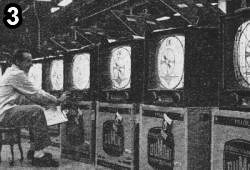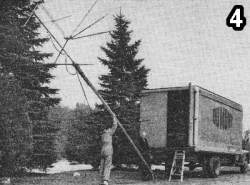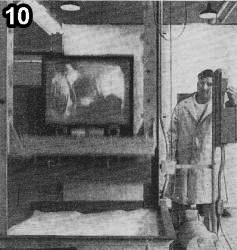|
March 1956 Popular Electronics
 Table of Contents Table of Contents
Wax nostalgic about and learn from the history of early electronics. See articles
from
Popular Electronics,
published October 1954 - April 1985. All copyrights are hereby acknowledged.
|
No, it's not a college engineering
class prank like the yearly
piano drop at MIT's Baker House or University of British Columbia
in Vancouver engineering students dangling a
VW Bug from the Golden Gate Bridge. This is water "dunking" test
carried out by a television manufacturer to assure that its products can survive
an accidental exposure to moisture. I assume the water below is fresh water and
not salt water. Vacuum tube TV sets were at a great disadvantage for survivability
compared to modern solid state sets with LCD displays. Even if the glass itself
remains intact, precisely aligned internal elements like deflection coils, grid
and plate structures can shift position and change both alignment and affect reliability.
Also, in the mid 1950s there was still a lot of point-to-point wiring of components
that had them suspended in air by their leads, resulting in mechanical fatigue.
The "walking wounded" phenomenon would result in a TV giving up the ghost earlier
than it otherwise might.
TV's Trial by Torture
By Carl J. Quirk
 Friday-night wrestling isn't the only kind
of roughhouse a TV set gets to see. Before it ever leaves the factory, a receiver
may catch a glimpse of some refined industrial torture. Friday-night wrestling isn't the only kind
of roughhouse a TV set gets to see. Before it ever leaves the factory, a receiver
may catch a glimpse of some refined industrial torture.
For instance? Well, delicate instruments tagged "Fragile! Handle With Care!"
are tossed around like potato sacks. Some of them are dunked in bathtubs, chilled,
heated, and even kicked downstairs.
This scientific mangling is carried on by experts - men who really know how to
give .machinery a hard time. It isn't done for fun, but because manufacturers want
to know just how much use, misuse, and abuse their products can take.
For while engineers can design just about any performance feature into a set,
they can't always be sure the feature is rugged enough to hold up in every set that
reaches a customer's house. To obtain this kind of information, they have to keep
close tabs on assembly-line production.
The job of finding mistakes and weaknesses is only one part of the testing operation.
It's even more important to keep mistakes from happening, so test information must
be fed back quickly to the production line.
Some kinds of tests are applied on a spot-check or sampling basis and other tests
are run on every set that comes off the line. The one shown above and those on the
next two pages are part of the day-to-day quality control system used by a major
electronics manufacturer.
 Production Testing. A quality control
station at the end of the production line (1) gives every set a look-and-listen
test for such items as noise, sensitivity, and sound and picture level. More thorough
bench tests are run on a random 25-set-a-day sample (2). In addition, 12 completed
sets (3) are uncrated daily, critically re-examined, and then operated for 24 hours. Production Testing. A quality control
station at the end of the production line (1) gives every set a look-and-listen
test for such items as noise, sensitivity, and sound and picture level. More thorough
bench tests are run on a random 25-set-a-day sample (2). In addition, 12 completed
sets (3) are uncrated daily, critically re-examined, and then operated for 24 hours.
 Field Testing. Even after a set
comes through factory tests with flying colors, it may still run into trouble when
it gets into a fringe-area home, or one that happens to be near a trolley line,
a police transmitter, a busy highway or some similar source of interference. To
obtain a sample of actual operation under every type of field condition, the factory
keeps a mobile test laboratory on the road. As shown at the right, engineers set
up their antenna in a typical location, a weak signal area, or one that's noted
for adjacent-channel interference. Inside the Field Testing. Even after a set
comes through factory tests with flying colors, it may still run into trouble when
it gets into a fringe-area home, or one that happens to be near a trolley line,
a police transmitter, a busy highway or some similar source of interference. To
obtain a sample of actual operation under every type of field condition, the factory
keeps a mobile test laboratory on the road. As shown at the right, engineers set
up their antenna in a typical location, a weak signal area, or one that's noted
for adjacent-channel interference. Inside the
 fully equipped lab truck (4, 5),
they get a customer's-eye view of most of the problems that arise in average homes
as well as in special, troublesome locations. Sets made by other manufacturers are
also checked in the field lab to provide comparative performance data. And in an
entirely separate field-test operation, factory representatives follow up customer
service problems and report back to the factory. fully equipped lab truck (4, 5),
they get a customer's-eye view of most of the problems that arise in average homes
as well as in special, troublesome locations. Sets made by other manufacturers are
also checked in the field lab to provide comparative performance data. And in an
entirely separate field-test operation, factory representatives follow up customer
service problems and report back to the factory.
 Type Testing. A set that's passed
a full series of "type" tests is usually ready for the graveyard. In this factory,
five units a day are given thorough electrical-characteristic tests covering 25
separate measurements. Samples are checked also for ruggedness under extreme conditions
of handling and use. The dunk test demonstrates (top photo) a set's ability to withstand
accidental wetting. Other ruggedness tests are shown below. Type Testing. A set that's passed
a full series of "type" tests is usually ready for the graveyard. In this factory,
five units a day are given thorough electrical-characteristic tests covering 25
separate measurements. Samples are checked also for ruggedness under extreme conditions
of handling and use. The dunk test demonstrates (top photo) a set's ability to withstand
accidental wetting. Other ruggedness tests are shown below.
 Screened room is used for electrical
"type" tests (6). By eliminating noise, interference, and broadcast signals, it
insures uniformity of all measurements. Screened room is used for electrical
"type" tests (6). By eliminating noise, interference, and broadcast signals, it
insures uniformity of all measurements.
Heat and humidity tests (7, 8) are carried out in a vault-like chamber where
temperature and moisture can be completely controlled by the test engineer.
 Drop test (9) checks the packaging.
It's important because set quality doesn't mean much unless the product can safely
survive the rigors of shipment. Drop test (9) checks the packaging.
It's important because set quality doesn't mean much unless the product can safely
survive the rigors of shipment.
Shake test - or vibration test - (10) is performed on a specially built jiggle
platform. The set is supposed to keep operating as usual during this ordeal.
 
 
Posted January 16, 2024
(updated from original
post on 2/13/2017)
|







































